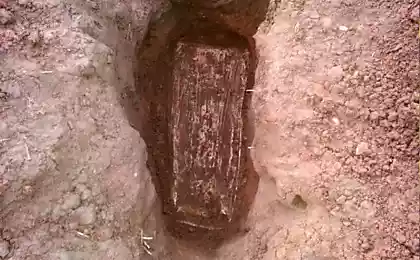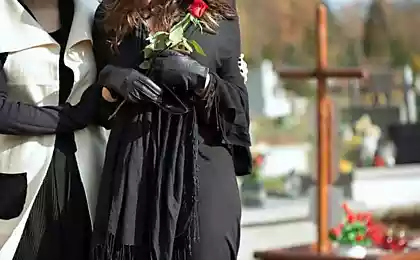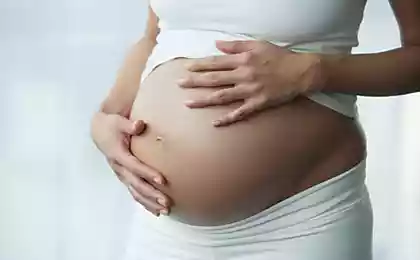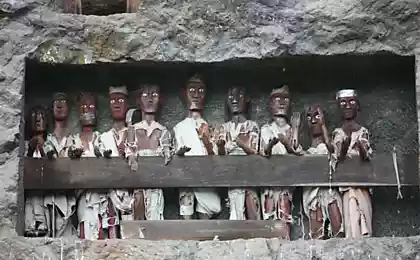3192
The most incredible funeral rituals (8 photos)
The memory of the dead is inherent in the people, without exception, all races and peoples. That is why in the world there are many different funeral rituals and traditions.
The memory of the dead is inherent in the people, without exception, all races and peoples. That is why in the world there are many different funeral rituals and traditions.
1. Burial of the Sardine, Spain
The history of popular tradition dates back several centuries. Despite its grim name, it affects fun, dancing, relaxed carnival procession, a riot of colors.
Burial of the Sardine Feast completes vseispansky carnival. Giant cardboard sardine to the sound of funeral music are outstretched hands of a few people up in carnival costumes. They are accompanied by the funeral procession wearing masks. Among them are weeping inconsolably "widow" (often mustachioed men). On the streets as is "groaning" and "crying." Eventually sardine burnt and her ashes buried in the ground.
Image folk festival of the same name can be seen on the picture of the great Goya. It is believed that the festival corresponds to the harvest festival, popular in many European countries.

2. Bone House, Halshtadt, Austria
In a small Gothic church in a remote alpine village are more than 600 painted human skulls, each of which is equipped with a sign with information about the "host." What to do when the church cemetery is too small, and the law provides for the sale of land, if the relatives of the deceased did not renew the lease after 25 years.

3. Hanging coffins, Sagada, Luzon, Philippines
Pogrimelny unique custom for two thousand years there in the depths of the island of Luzon in the Philippines. The dead bury their own in hollowed logs, and then refer to the caves in the mountains. In some caves, there are up to several hundreds of original coffins. A similar ritual is found in some regions of China and Indonesia. Unfortunately, some tourists who manage to get to the graves, sometimes take bone locals as souvenirs.

4. Cave grave Lemo, Tana Toraja, Indonesia
A lot of time passes between the death of the person and the recognition of its dead at the Indonesian people Toraja. Late they call "sleeping" mummified and kept for years in a tomb, yet there is a preparation for the final rituals. It is believed that the soul is "sleeping" at this time going on a journey to the land of spirits, and he is not dead yet, just sick. "Official" death comes when the corpse of the deceased several times thrown up, and then put your feet to the south. In carved in rock crevices cave tombs can be seen dozens of similar dolls figures. These figures, called tau tau, to protect the peace of the dead, buried behind them.

5. Heaven burial, Tibet
For most ordinary Tibetans (except for llamas and some others) "heavenly funeral" was a common way to say goodbye to the body shell after the "empty vessel" left an immortal soul. Dismembered corpse into pieces and carried into the mountains to be eaten by vultures. It is believed that these birds of prey are Dakini, feminine aspects of the Buddha, angels counterparts. Dakini raise souls to heaven, where they await their next reincarnation. Following the virtues of Sakyamuni, who fed his flesh hawk, dove to save the human body is donated to the birds in the salvation of their usual victims.

6. flooding Cemetery, Camiguin, Philippines
Among the attractions of the island is an old city cemetery, sunk under the sea with the old capital after a volcanic eruption in 1871. Now, this place marks a huge cross, set in 1982. Popular among divers place.

7. Mummies Nazca, Nazca, Peru
Despite the devastation produced by robbers, a small amount of Nazca mummies are still preserved in the Atacama Desert. Some members of this mysterious culture that disappeared centuries ago, there were long waving in the wind "spit", indicating the high status during his lifetime.
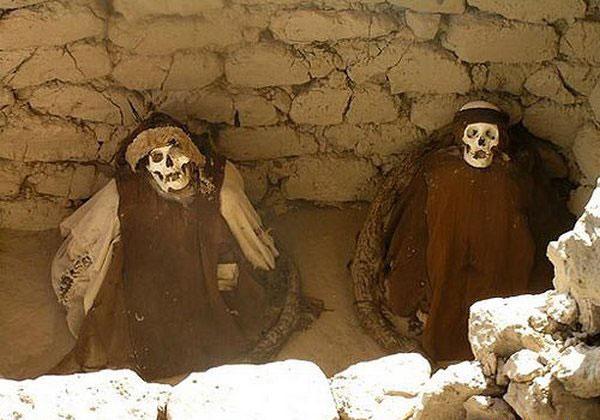
8. Rock tombs, Myra, Turkey
The complex of tombs carved into the rocks looks more like a majestic castle, rather than as an ancient cemetery. The uniqueness and originality of the tombs can be explained by the fact that the peoples of Lycia was the custom of burying the dead in the high places, because it was assumed that it will help them get to heaven. Age first burials at least two thousand years.

The memory of the dead is inherent in the people, without exception, all races and peoples. That is why in the world there are many different funeral rituals and traditions.
1. Burial of the Sardine, Spain
The history of popular tradition dates back several centuries. Despite its grim name, it affects fun, dancing, relaxed carnival procession, a riot of colors.
Burial of the Sardine Feast completes vseispansky carnival. Giant cardboard sardine to the sound of funeral music are outstretched hands of a few people up in carnival costumes. They are accompanied by the funeral procession wearing masks. Among them are weeping inconsolably "widow" (often mustachioed men). On the streets as is "groaning" and "crying." Eventually sardine burnt and her ashes buried in the ground.
Image folk festival of the same name can be seen on the picture of the great Goya. It is believed that the festival corresponds to the harvest festival, popular in many European countries.

2. Bone House, Halshtadt, Austria
In a small Gothic church in a remote alpine village are more than 600 painted human skulls, each of which is equipped with a sign with information about the "host." What to do when the church cemetery is too small, and the law provides for the sale of land, if the relatives of the deceased did not renew the lease after 25 years.

3. Hanging coffins, Sagada, Luzon, Philippines
Pogrimelny unique custom for two thousand years there in the depths of the island of Luzon in the Philippines. The dead bury their own in hollowed logs, and then refer to the caves in the mountains. In some caves, there are up to several hundreds of original coffins. A similar ritual is found in some regions of China and Indonesia. Unfortunately, some tourists who manage to get to the graves, sometimes take bone locals as souvenirs.

4. Cave grave Lemo, Tana Toraja, Indonesia
A lot of time passes between the death of the person and the recognition of its dead at the Indonesian people Toraja. Late they call "sleeping" mummified and kept for years in a tomb, yet there is a preparation for the final rituals. It is believed that the soul is "sleeping" at this time going on a journey to the land of spirits, and he is not dead yet, just sick. "Official" death comes when the corpse of the deceased several times thrown up, and then put your feet to the south. In carved in rock crevices cave tombs can be seen dozens of similar dolls figures. These figures, called tau tau, to protect the peace of the dead, buried behind them.

5. Heaven burial, Tibet
For most ordinary Tibetans (except for llamas and some others) "heavenly funeral" was a common way to say goodbye to the body shell after the "empty vessel" left an immortal soul. Dismembered corpse into pieces and carried into the mountains to be eaten by vultures. It is believed that these birds of prey are Dakini, feminine aspects of the Buddha, angels counterparts. Dakini raise souls to heaven, where they await their next reincarnation. Following the virtues of Sakyamuni, who fed his flesh hawk, dove to save the human body is donated to the birds in the salvation of their usual victims.

6. flooding Cemetery, Camiguin, Philippines
Among the attractions of the island is an old city cemetery, sunk under the sea with the old capital after a volcanic eruption in 1871. Now, this place marks a huge cross, set in 1982. Popular among divers place.

7. Mummies Nazca, Nazca, Peru
Despite the devastation produced by robbers, a small amount of Nazca mummies are still preserved in the Atacama Desert. Some members of this mysterious culture that disappeared centuries ago, there were long waving in the wind "spit", indicating the high status during his lifetime.

8. Rock tombs, Myra, Turkey
The complex of tombs carved into the rocks looks more like a majestic castle, rather than as an ancient cemetery. The uniqueness and originality of the tombs can be explained by the fact that the peoples of Lycia was the custom of burying the dead in the high places, because it was assumed that it will help them get to heaven. Age first burials at least two thousand years.




